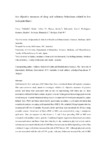Mostrar o rexistro simple do ítem
Are objective measures of sleep and sedentary behaviours related to low back pain flares?
| dc.contributor.author | Costa, Nathalia | |
| dc.contributor.author | Smits, Esther J. | |
| dc.contributor.author | Kasza, Jessica | |
| dc.contributor.author | Salomoni, Sauro | |
| dc.contributor.author | Rodríguez-Romero, Beatriz | |
| dc.contributor.author | Ferreira, Manuela L. | |
| dc.contributor.author | Hodges, Paul W. | |
| dc.date.accessioned | 2023-12-04T09:12:31Z | |
| dc.date.available | 2023-12-04T09:12:31Z | |
| dc.date.issued | 2022-09 | |
| dc.identifier.citation | Costa N, Smits EJ, Kasza J, Salomoni S, Rodriguez-Romero B, Ferreira ML, Hodges PW. Are objective measures of sleep and sedentary behaviours related to low back pain flares? Pain. 2022 Sep 1;163(9):1829-1837. | es_ES |
| dc.identifier.issn | 0304-3959 | |
| dc.identifier.uri | http://hdl.handle.net/2183/34419 | |
| dc.description | Final peer-reviewed manuscript | es_ES |
| dc.description.abstract | [Abstract] Risk factors for low back pain (LBP) flares have been considered about self-reported measures. This case–crossover study aimed to investigate whether (1) objective measures of physical activity and sleep were associated with the risk of experiencing LBP flares and (2) these associations differed for flares defined as pain 2 or more points greater than average pain over the period using an 11-point Numerical rating scale (0-no pain and 10-worst pain imaginable) (pain-defined flare: PDF) and flares identified by participants according to a broader definition that considered emotions or coping (self-reported flare [SRF]). We included 126 participants who had experienced LBP for >3 months. Physical activity and sleep were monitored for 28 days using wearable sensors. Occurrence of flares (PDF or SRF) was assessed daily using a smartphone application. Data on exposure to risk factors 1, 2, and 3 days preceding PDF or SRF were compared with nonflare control periods. Conditional logistic regression determined association between each factor and flares. Data show that day-to-day variation in physical activity and in-bed time are associated with the risk of LBP flares, but associations differ depending on how flare is defined. Longer in-bed time increased the risk of PDF but not SRF. Although physical activity was not associated with the risk of PDF, greater sedentary behaviour increased the risk of SRF and being more physically active decreased the risk for SRF. These results highlight the potential role of targeting sleep and physical activity in interventions to prevent LBP flares and indicate that risk factors differ depending on how LBP flares are defined. | es_ES |
| dc.description.sponsorship | Centre of Research Excellence (Australia); APP1091302 | es_ES |
| dc.description.sponsorship | Centre of Research Excellence (Australia); APP1079078 | es_ES |
| dc.description.sponsorship | National Health and Medical Research Council (NHMRC) of Australia; PH—APP1102905 | es_ES |
| dc.description.sponsorship | National Health and Medical Research Council (NHMRC) of Australia; MF—APP1143593 | es_ES |
| dc.language.iso | eng | es_ES |
| dc.publisher | Lippincott | es_ES |
| dc.relation.uri | https://doi.org/10.1097/j.pain.0000000000002585 | es_ES |
| dc.subject | Low back pain | es_ES |
| dc.subject | Risk factors | es_ES |
| dc.subject | Triggers | es_ES |
| dc.subject | Flares | es_ES |
| dc.subject | Sleep | es_ES |
| dc.subject | Physical activity | es_ES |
| dc.subject | Sensors | es_ES |
| dc.title | Are objective measures of sleep and sedentary behaviours related to low back pain flares? | es_ES |
| dc.type | info:eu-repo/semantics/article | es_ES |
| dc.rights.access | info:eu-repo/semantics/openAccess | es_ES |
| UDC.journalTitle | Pain | es_ES |
| UDC.volume | 163 | es_ES |
| UDC.issue | 9 | es_ES |
| UDC.startPage | 1829 | es_ES |
| UDC.endPage | 1837 | es_ES |
Ficheiros no ítem
Este ítem aparece na(s) seguinte(s) colección(s)
-
GI-IPRF - Artigos [140]






